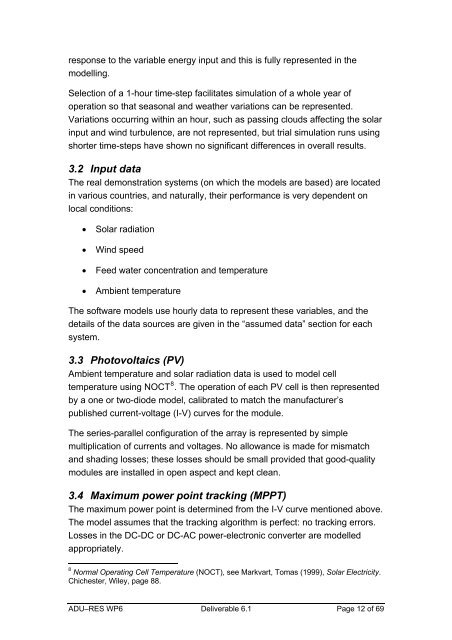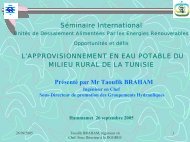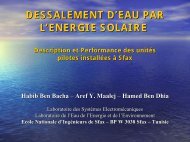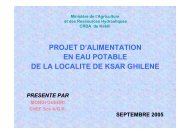Energy consumption modelling - ADU-RES
Energy consumption modelling - ADU-RES
Energy consumption modelling - ADU-RES
Create successful ePaper yourself
Turn your PDF publications into a flip-book with our unique Google optimized e-Paper software.
esponse to the variable energy input and this is fully represented in the<br />
<strong>modelling</strong>.<br />
Selection of a 1-hour time-step facilitates simulation of a whole year of<br />
operation so that seasonal and weather variations can be represented.<br />
Variations occurring within an hour, such as passing clouds affecting the solar<br />
input and wind turbulence, are not represented, but trial simulation runs using<br />
shorter time-steps have shown no significant differences in overall results.<br />
3.2 Input data<br />
The real demonstration systems (on which the models are based) are located<br />
in various countries, and naturally, their performance is very dependent on<br />
local conditions:<br />
• Solar radiation<br />
• Wind speed<br />
• Feed water concentration and temperature<br />
• Ambient temperature<br />
The software models use hourly data to represent these variables, and the<br />
details of the data sources are given in the “assumed data” section for each<br />
system.<br />
3.3 Photovoltaics (PV)<br />
Ambient temperature and solar radiation data is used to model cell<br />
temperature using NOCT 8 . The operation of each PV cell is then represented<br />
by a one or two-diode model, calibrated to match the manufacturer’s<br />
published current-voltage (I-V) curves for the module.<br />
The series-parallel configuration of the array is represented by simple<br />
multiplication of currents and voltages. No allowance is made for mismatch<br />
and shading losses; these losses should be small provided that good-quality<br />
modules are installed in open aspect and kept clean.<br />
3.4 Maximum power point tracking (MPPT)<br />
The maximum power point is determined from the I-V curve mentioned above.<br />
The model assumes that the tracking algorithm is perfect: no tracking errors.<br />
Losses in the DC-DC or DC-AC power-electronic converter are modelled<br />
appropriately.<br />
8<br />
Normal Operating Cell Temperature (NOCT), see Markvart, Tomas (1999), Solar Electricity.<br />
Chichester, Wiley, page 88.<br />
<strong>ADU</strong>–<strong>RES</strong> WP6 Deliverable 6.1 Page 12 of 69







